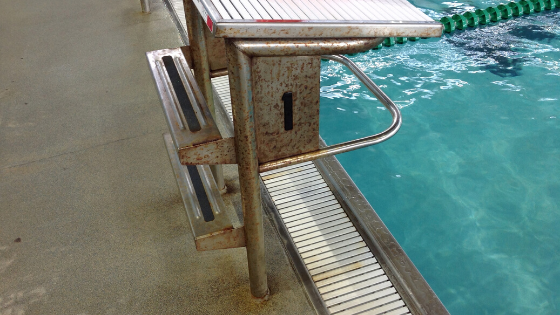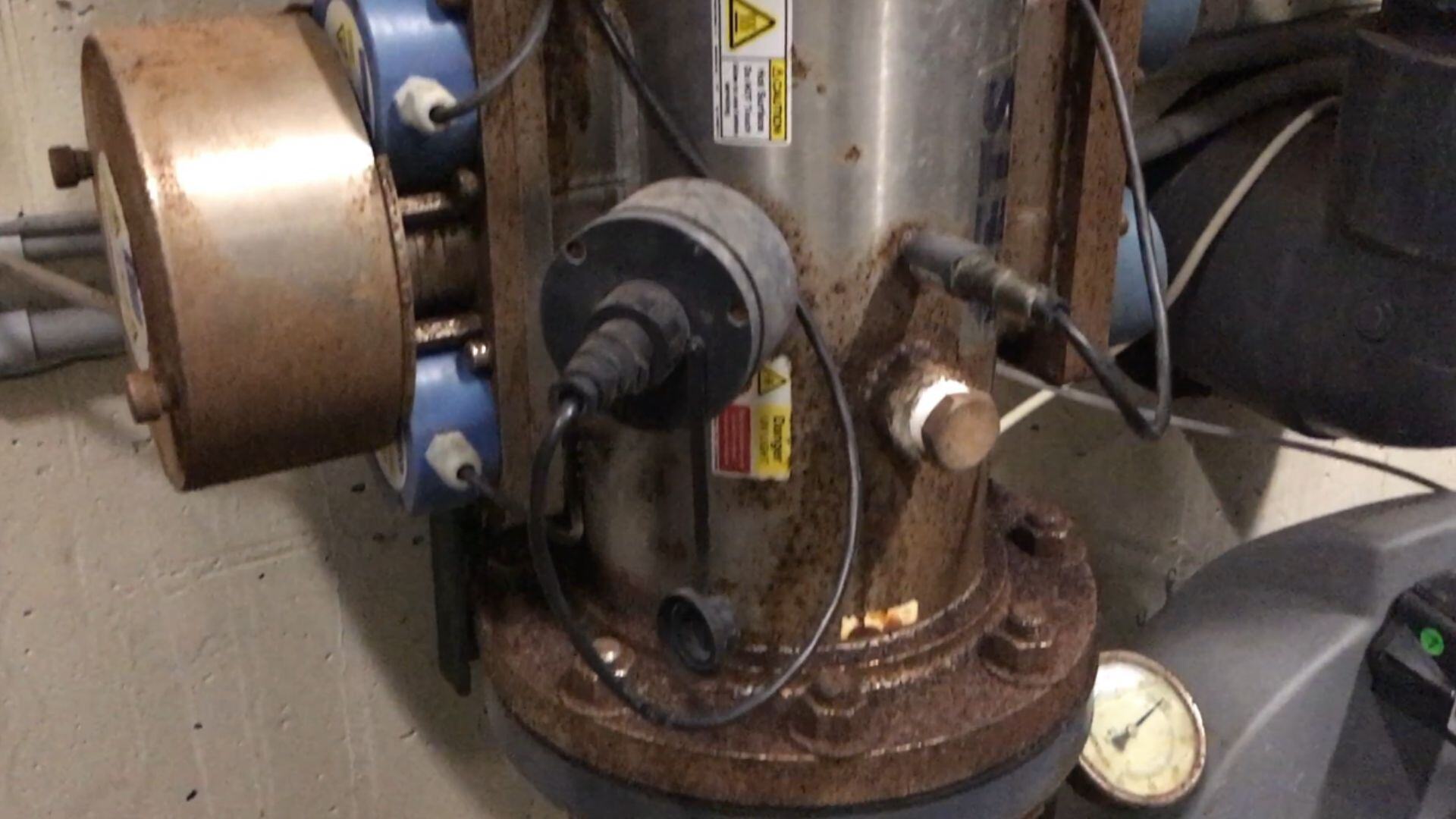Why do indoor pools rust and corrode so easily?
This article expands upon our previous article about stainless steel corrosion. While that article talked about stainless steel specifically, this article covers rust and corrosion more broadly in the natatorium space as it pretains to humidity, condensation and chloramine pollution.
Covered in this article:
- What is corrosion?
- Oxidation and rust
- Why does chloramine corrosion on stainless steel look spotty?
- Material failures and risks
- Oxidation and rust
- Factors that accelerate corrosion in indoor pools
- Moisture
- Chloramine pollution
- Low pH
- Chlorine vs. chlorides
- Ways to reduce and prevent corrosion in indoor pools
- Proper dehumidification
- Appropriate ventilation
- Good pool water chemistry
- Cleaning
- Corrosion-resistant building materials
- Conclusion
What is corrosion?
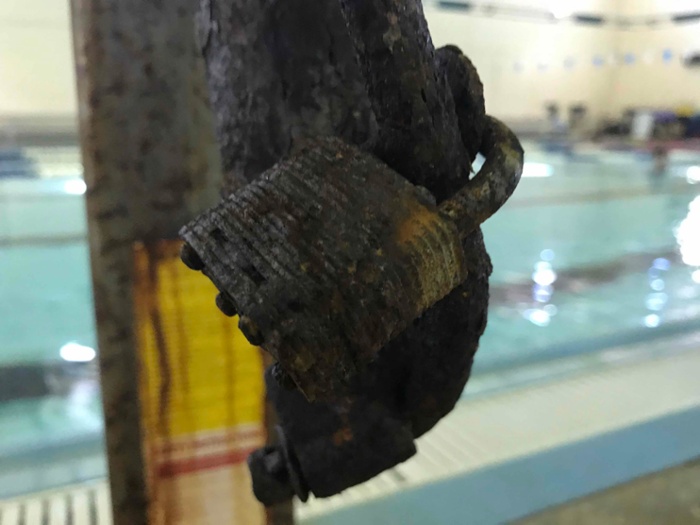
Corrosion is an electrochemical process of removing electrons from a substance (usually metal). Sometimes this is accomplished via oxidation, in which an oxidizer takes electrons from the metal and replaces it with oxygen, creating an oxide. Perhaps the most common example of this is iron rusting into ferrous oxide.
For our purposes, we talk about corrosion because metals in and around swimming pools get destroyed due to indoor pool (and chemical room) environments. To better manage commercial pools, it helps to know what we're up against.
Oxidation and rust
By far, the most common corrosion we deal with is oxidation of ferrous metals. In swimming pool facilities, this includes any type of ferrous metal that contains iron.% These include various steel types (stainless steel, galvanized steel, carbon steel, etc.) and cast-iron components that may be found in a pump room (like old strainer baskets and pump housings).
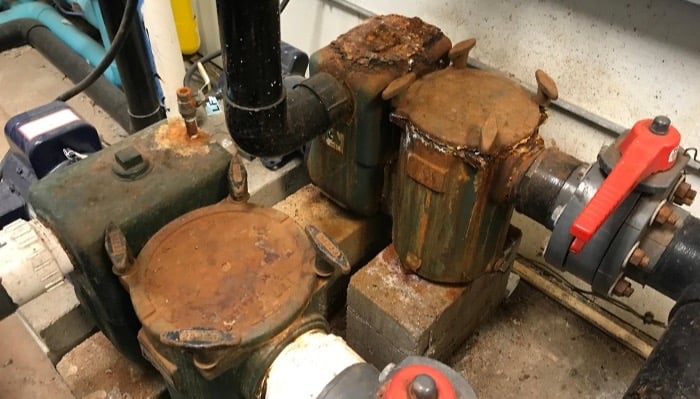 Two rusting cast-iron pool pumps and strainer baskets in a pool pump room
Two rusting cast-iron pool pumps and strainer baskets in a pool pump room
Oxidation of metals occurs easily in indoor pools partly because of the moisture content in the air. For oxidation of metals to happen, you need an anode (in this case, iron or other ferrous metal), a cathode (like oxygen or an oxidizer like chlorine), and a mechanism for transfering electrons between them. In indoor pools, water is the catalyst that allows for electron transfer to occur. Water is a suprisingly good catalyst, thanks to its conductivity when salts (sodium and chloride ions) are in the water. All chlorine products leave chlorides behind, so pool water is conductive to some extent.
We go in depth on the chemistry of how iron rusts in our other article. In short, iron loses electrons to become ferrous ion (Fe2+), then another electron to become ferric ion (Fe3+), which interacts with water to precipitate iron oxides and hydroxides, the primary components of rust.
Why does chloramine corrosion on stainless steel look spotty?
Before explaining the chemistry, let's start with the physics. Moisture in the air will condense on metal surfaces because they tend to be colder than other surfaces (like brick). If the cold surface is colder than the dew point, the moisture in the air condenses into droplets of water (condensation). This water is acidic and chlorinated (as we'll explain in a moment). This is why rust in indoor pools almost looks like it was sprayed on, rather than being a solid blob of rust. The spotted pattern is from droplets of water condensing on the surface, then evaporating away.


Material failures and risks
Rust and corrosion are not just unsightly; they can be dangerous. In our previous article we mentioned a few case studies where corrosion was actually lethal, as heavy objects supported by metal brackets fell. The brackets failed due to corrosion. These failures will continue to happen unless the metals are cleaned, sealed, and/or coated to prevent further corrosion. Metals can literally crumble apart over time if corrosion continues unchecked.
In 2024, several pool guests at a natatorium in Colorado were almost killed when a large air duct fell from the ceiling. It fell thanks to corrosion that had weakened the support brackets to a point where they failed.
Once rust starts, it can create a deleterious cycle that does not stop. According to a metallurgist we interviewed in our previous article about corrosion, the loss of material has to do with the oxides being larger molecules and spalling off:
"Ferric oxide doesn’t form a continuous layer on the steel because the oxide molecule has a larger volume than the underlying iron atoms, and eventually spalls off leaving fresh steel exposed which then starts a deleterious rusting cycle." - Alex Wensley
In other words, rust will spread. As more oxygen (or another oxidizer) meets exposed ferrous material, it will continue. Water accelerates this as the elecrolytic catalyst. The moisture in natatoriums gives ample water to these surfaces to continue corroding.
The risks associated with corrosion should be obvious. We have visited natatoriums that have had such major corrosion that the building structure itself was compromised. Here's a steel I-beam supporting the roof above a pool:

Do you think this structural I-beam is compromised? The hazard should be obvious, because even a partial roof collapse could be lethal. This photo was taken in a facility with bad indoor air quality that had persisted for years. Chloramines and moisture were major contributors to this severe corrosion.
Another common place we see corrosion is on metal support brackets for lights and overhead air ducts. These objects are heavy and can fall if the support brackets fail. We have evaluated countless facilities where this was observed, and we always recommend replacing such structural elements with corrosion-proof (or at least corrosion-resistant) alternatives.
Factors that accelerate corrosion in indoor pools
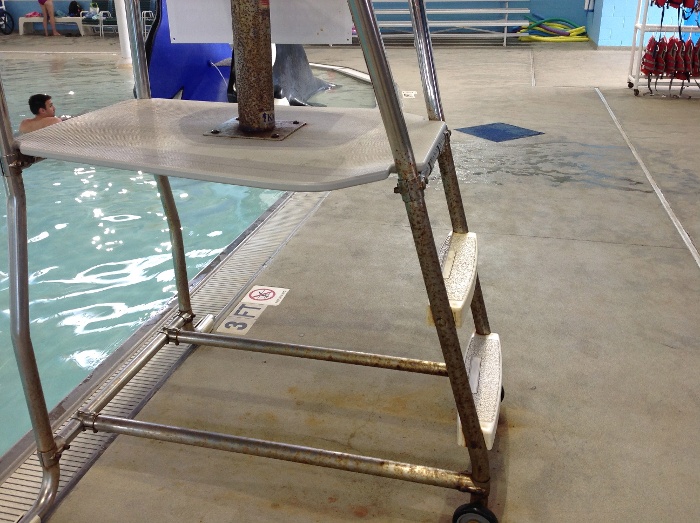
So why do indoor pools corrode more than other indoor spaces, like classrooms, offices, gyms and cafeterias? It's simple. Natatoriums have the perfect storm of humidity and chloramine pollution.
Moisture
The amount of moisture in the air of an indoor swimming pool is substantially more than other indoor rooms. The moisture demand is why air conditioners cannot keep up, and why pools need dedicated pool dehumidifiers instead. To maintain the optimal 50-55% relative humidity in a natatorium, an incredible amount of moisture needs to be pulled out of the air. And when we talk about moisture, the concepts of evaporation, humidity, condensation and dew point all matter. As mentioned earlier, what happens is moisture in the air condenses on cold metals, which is why the corrosion looks the way it does.
To give you some perspective, a properly dehumidified pool will evaporate approximately its entire volume of water every year. That's a LOT of moisture in the air.
Related: The Case for Recycling Pool Dehumidifier Condensation
And it's not just any moisture. If the pool facility does not have a dedicated mechanism for capturing and removing chloramine pollution, corrosion is virtually inevitable.
Chloramine pollution
It is no secret that chloramines and other airborne disinfection byproducts (DBPs) are harmful. They are are a health concern for people, and a corrosion concern for metal components. They can literally decay facilities by destroying metal components–including structural steel and electronics.
So what is it about chloramines and other DBPs that makes them so corrosive? It's actually their chemistry itself, which can be summarized by two traits: low pH and a high concentration of chlorides.
Low pH
The condensation that drips out of pool dehumidifier evaporator coils tends to have a low pH. This is especially true in natatorium facilities that struggle with chloramine pollution, and have low return grilles. Check out this photo of condensation runoff from a pool dehumidifier, which trickles out of the system and across a concrete sidewalk:
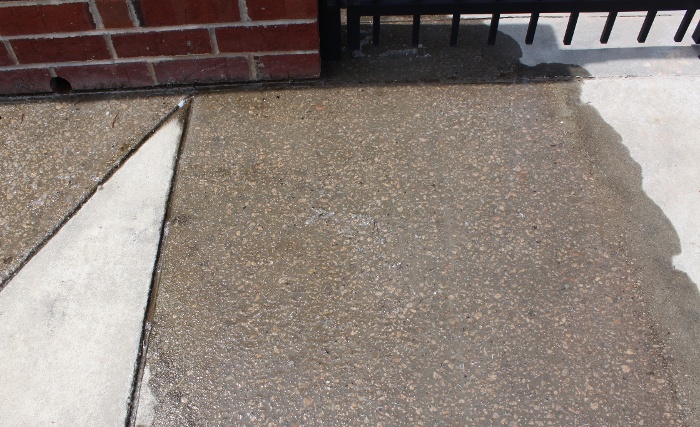 Look at the condition of the dry concrete compared to the wet concrete. You can see the wet concrete has been etched for some time. This is due to the low pH and high chloride concentration of the condensate.
Look at the condition of the dry concrete compared to the wet concrete. You can see the wet concrete has been etched for some time. This is due to the low pH and high chloride concentration of the condensate.
Chloramines are acidic, which means the pH of condensation water on metals is low. And when this low-pH condensation evaporates off of metal surfaces, its minerals and other chemistries–namely chlorides and salts–stay behind. If you want to see what the inside of the evaporator coil looks like on a pool dehumidifier, open up the unit and see for yourself. Or here's a photo of one just seven years old:
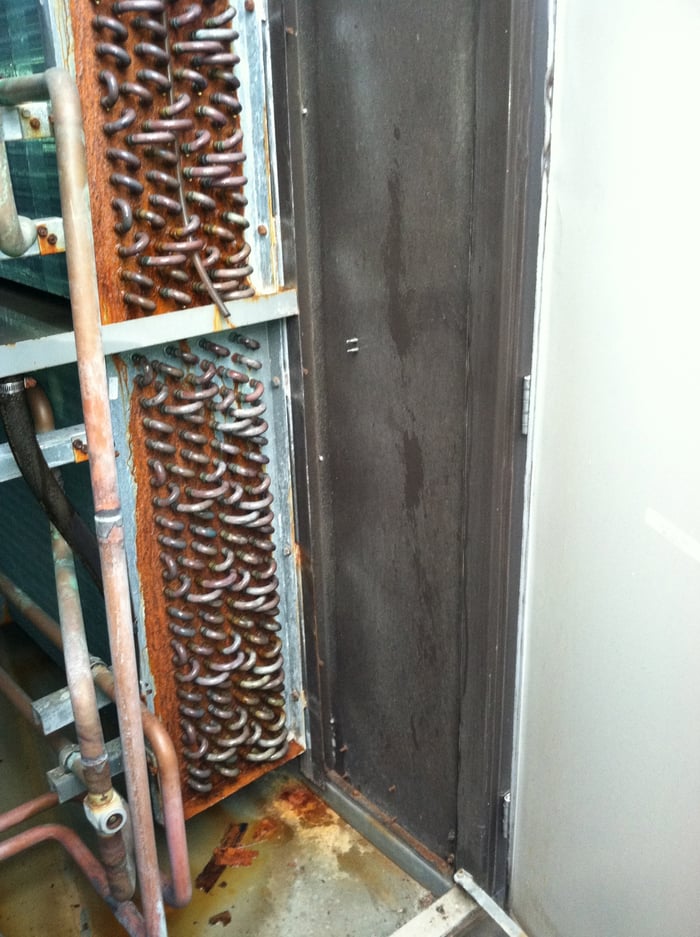 Corrosion is taking over this pool dehumidifier's evaporator coil. The condensation (moisture pulled out of the air) has a low pH and high chloride concentration. This water is corrosive, as you can see.
Corrosion is taking over this pool dehumidifier's evaporator coil. The condensation (moisture pulled out of the air) has a low pH and high chloride concentration. This water is corrosive, as you can see.
Chlorides
Chlorides (Cl-) are negatively-charged chlorine atoms that no longer have sanitizing capabilities. In other words, they are reduced chlorine atoms that have become anions.2 Swimming pools are loaded with chlorides to begin with, because several of the most commonly-used chemicals leave chlorides behind. For instance, all types of chlorine dissolve in water to create Hypochlorous Acid (HOCl) and Hydrochloric acid (HCl). Both of which leave behind chlorides.
In commercial pools, the most common chlorine types are liquid chlorine (sodium hypochlorite) and cal hypo (calcium hypochlorite). Both of these leave behind chlorides. Muriatic acid (31.45% HCl) also leaves behind chlorides. Also, if you want to add calcium to the water to increase calcium hardness, the product most commonly used in swimming pools is calcium chloride (CaCl2).
The type of inorganic chloramine that off-gasses is called Trichloramine, but it's actual chemical name is nitrogen trichloride. This is important because chlorides are known to attack metals and cause corrosion.3
Ways to reduce and prevent corrosion in indoor pools
"An ounce of prevention is worth a pound of cure." - Benjamin Franklin
It is far easier and more cost-effective to prevent corrosion from the beginning. This can be accomplished with proactive natatorium design and equipment specifications, detailed installation guidelines, and the use of the correct building materials. From an operations standpoint, regular cleaning and maintenance is also necessary.
Proper dehumidification
Dehumidification is the removal of moisture from air, and air conditioning is adjusting the temperature of the air. A correctly-sized pool dehumidifier unit (PDU) is necessary for indoor pools. No, air conditioning units are not sufficient to handle the moisture demands of an indoor pool. Under-sizing and selecting the wrong type of dehumidifer is one of the top five mistakes we see in natatoriums. Remember that a properly-dehumidified swimming pool will evaporate approximately its entire volume of water each year. Air conditioners are not capable of pulling that kind of moisture out of the air.
Furthermore, the energy required to dehumidify an indoor pool is immense. Pool dehumidifiers are designed to optimize energy efficiency with reheat coils and pre-heating outside air. For more information on how this works, contact some pool dehumidifier manufacturers.
Appropriate ventilation
Ventilation is different from dehumidification, but they are both a part of the mechanical HVAC system. While dehumidification is the removal of moisture from the air, ventilation is the movement, capture, and exchange of air. For the purposes of this article, let's focus on air capture and removal.
We know that warm moisture rises and expands. As a result of this, standard practices for decades of natatorium HVAC design has been to put exhausts in the ceiling, and returns above the pool. Sure, that captures moisture, but the worst air in the room is not being pulled out of the room. That's because chloramine pollution is heavier than oxygen. Chloramines and other DBPs do not behave the same way that humid air does.
Related: The Mechanical Engineer's Indoor Pool Dilemma
Approptiate ventilation in pools means two things:
- The warm, moist air gets dehumidified by the PDU, and
- The heavy chloramine pollution gets captured and removed from the space, and not recirculated
Source-capture exhaust is the best answer we know of to efficiently remove heavy chloramine pollution from the lowest parts of the room. And nowadays, the major pool dehumidifier manufacturers have accepted this technology and can integrate with it. They all recognize the importance of source-capture exhaust not only for indoor air quality, but for protecting the facility and their PDU from corrosion.
Good pool water chemistry
It's easy for people to point to the pool operator and say "fix your water", but in reality that's not entirely fair. Even the best operators with state-of-the-art swimming pool systems cannot stop 100% of chloramine off-gassing. Chloramines are a natural byproduct of chlorination when nitrogen gets into the pool. Sure, operators can take steps to reduce nitrogen from getting in the pool, and so can swim coaches and swimmers (stop peeing in the pool, and shower before swimming).
But can the operator really enforce such rules? Not really.
The best we can hope for is good disinfection practices without overchlorinating the water, as well as utilizing secondary disinfection systems like UV, Ozone, or AOP. Hyper-dissolve oxygen (HDO) should be mentioned here, though it's not technically a secondary disinfection system.4 To further improve water quality, enzymes can be utilized to break down organic material and improve chlorine efficiency.

For instance, enzymes can break down the organic components of Urea, simplifying it down into inorganic ammonia and other nitrogen compounds. This makes it easier for chlorine to remove the ammonia and create chloramines (and then destroy them) faster.
Cleaning
Regular cleaning can remove chloride-laden moisture from metal fixtures. Think any and all metal rail goods like lifeguard chairs, ladders, backstroke flag poles, and starting blocks. These fixtures should be cleaned regularly with an appropriate stainless steel cleaner that contains no nitrogen/ammonia.
Corrosion-resistant building materials
Aside from the necessity of a solid vapor barrier, architects and engineers should be specifying appropriate building materials in and around the pool and pump room. There are epoxy coatings, sealant products and other ways to protect the facility from corrosion. Use of plastics and aluminum are also recommended in many cases.
Conclusion
Corrosion and rust happens in indoor swimming pools so easily because of the conditions in the space. We have to deal with warm, humid air that likes to condense on cold surfaces (like metals). This condensation is corrosive thanks to two properties of chloramines: low pH and high chloride concentration. And because condensation forms in droplets on cold surfaces, that's why pool corrosion is almost always in droplet patterns, like it was sprayed on.
To prevent corrosion, take a multi-pronged approach. Have proper dehumidification with optimal airflow and return locations to capture the warmest, most-humid air. Then, utilize source-capture exhaust to remove heavy chloramine pollution. Use corrosion-resistant or corrosion-proof building materials, and seal weaknesses to protect structural steel from ever being exposed to the air in the pool.
On the water side, utilize enzymes and secondary systems to optimize disinfection and oxidation. And if at all possible, develop a facility culture of preventing nitrogen from getting into the water as much as possible.
If you see corrosion in your facility, perhaps we can help you identify ways to address it before it's too late.
1 Fe2O3 Iron (III) oxide. Chemical Compound Formulas. BYJUS.com.
2 Normally, we do not cite Wikipedia. But after reading nearly a dozen other sources looking for a cogent definition of chlorides, we decided Wikipedia actually has the simplest definition we could find. We know what chlorides are, generally speaking, but it's helpful to link to a published definition. Chlorides are negatively charged anions, which are reduced chlorine atoms. They can stand alone or be bound to other substances. The point is, they are everpresent in water in various forms. https://en.wikipedia.org/wiki/Chloride
3 Montemor, M.F., Simões, A.M.P., Ferreira, M.G.S.. (2002). Chloride-induced corrosion on reinforcing steel: from the fundamentals to the monitoring techniques. Grupo de Corrosão e Efeitos Ambientais, DEQ. Instituto Superior Técnico, AV. Rovisco Pais., 1049-001. Lisboa, Portugal. https://doi.org/10.1016/S0958-9465(02)00089-6
4 HDO injects purified oxygen into the water, which visibly improves the water quality and air quality in the space. Fresh air dilutes chloramines in the breathing zone, making the swimmer experience much more pleasant. We can confirm this from first-hand experience in multiple facilities with such systems. For more information about HDO, visit AquaGen by Pure Vision Technologies.
% Ferrous means a substance that contains iron (Fe). Chlorides are known to attack ferrous metals. You can learn more about how and why this happens here: https://www.civilengineeringforum.me/chloride-induced-corrosion-mechanism/

 By
By

